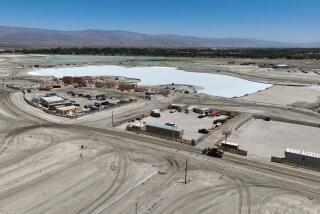Fanita Ranch Deal Sets Stage for Huge Santee Development
- Share via
SANTEE — A huge housing, commercial and industrial project that may add as many as 24,000 residents over the next decade to this rapidly growing East County city was announced Thursday by Genstar Southwest Development.
The development company, a subsidiary of the Genstar Corp. of Canada, said it bought 2,400 acres of land in an area commonly known as Fanita Ranch, a scenic valley with many hills just north of the city. The purchase was recorded late Tuesday, but terms of the transaction weren’t disclosed.
The land--bought from Carlton Santee Corp., another development company--represents one-quarter of the entire city of Santee and 41% of all undeveloped land in the city limits.
“Because San Diego’s growth is limited on three sides by the Pacific Ocean, Mexico and Camp Pendleton, I believe the eastern areas of the county will assume greater significance over the next decade,” Genstar Southwest President Robert B. McLeod said in a prepared statement.
Santee officials, who had been aware of the Genstar negotiations for several months, were elated at the announcement, saying the project will allow the city, which until recently was more identified with helter-skelter growth, to work with one developer in planning the entire area.
The enormity of the project, others said, will be felt throughout the region, particularly by commuters on busy Interstate 8, the main corridor between East County and San Diego. Clearly, the development will have a substantial impact on Santee itself, a burgeoning community rapidly shedding its rural image.
Over the last decade, its population has grown to about 50,000, an increase of 23%.
Projections made by the San Diego Assn. of Governments (Sandag) estimate the population of Santee--which incorporated only five years ago--will reach 71,600 by the year 2000. And that’s without counting the full impact of the Genstar proposal. But city officials think that, with the proper planning, many problems related to rapid growth can be avoided.
“We think it’s very positive a multinational company has targeted this area,” said Ron Ballard, Santee city manager. He cited the advantages to the city in working with a single company in planning for the future of Fanita Ranch, rather than with several competing developers.
The Santee City Council and Planning Commission are drafting a detailed master development plan for the Fanita Ranch area, a document that should be completed sometime this spring, Ballard said.
Santee City Councilman Jim Bartell, the only one of five original City Council members elected to a second term, said he’s “excited about the potential for the area and the reputation” of Genstar.
“We’re looking toward quality and innovation,” Bartell said.
Genstar is one of the county’s largest landowners. The company became involved in San Diego in 1978 when it bought Rancho Penasquitos. It later bought 1,000 acres in Rancho Bernardo and developed Bernardo Heights there. The firm also has interests in San Diego’s Golden Triangle, an area of intense commercial and office development east of La Jolla and UC San Diego.
Fanita Ranch is the company’s second-largest California land holding, behind Rancho Penasquitos.
Paul Cote, project manager for the Santee development, said it will take the company two years to develop its master plan and prepare the property, and another 10 years, depending on market conditions, to complete construction.
As it prefers to do, Genstar won’t be involved in the actual construction. That will be left up to other developers, who will buy the various parcels from the company, said Genstar spokesman Richard Daniels.
Cote said the proposal for Fanita Ranch includes a full range of housing, from single-family homes to condominiums to apartments. In all, about 6,000 to 8,000 dwelling units will be built. In addition, the land will be put to other uses such as industrial, commercial and office developments. None of the proposals, however, has yet been refined, Cote said.
“This is a very large, significant parcel . . . and the importance of a master plan is that it can have a positive impact on Santee,” Cote said.
“We want to make sure that our ideas are close to theirs (city officials),” Cote said.
As for the reason behind the selection of Santee, Daniels said: “Santee was picked because, in the intermediate- and long-term, North County is saturated. This is where the next wave (of growth) is going to go. It’s as much a process of elimination as anything else.”
Sandag officials say Santee is already one of the fastest-growing cities in the county, behind only San Marcos and Carlsbad.
“This proposal will add more people and more traffic and more air pollution,” said Susan Carnevale, an associate research analyst for Sandag, which tracks regional growth trends. “Because of its size, it’s going to have impacts on surrounding cities as well, such as El Cajon to the south, maybe La Mesa.”
Regionally, she said, the Genstar development can be expected to “add significant volumes of traffic to the freeways there. To go anywhere to the west, to Kearny Mesa, to downtown, people have to take I-8,” a freeway already crowded during prime commuting hours.
More to Read
Sign up for Essential California
The most important California stories and recommendations in your inbox every morning.
You may occasionally receive promotional content from the Los Angeles Times.













